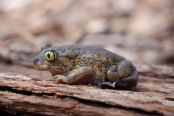Scaphiopus holbrookii (Harlan, 1835)

Key Characters: Plump body; vertical pupil; one large, black, elongate digging spade under heel of each hind foot.
Similar Species: American Toad and Fowler’s Toad are squat and plump, but do not have the vertical pupil. See Key to Frogs & Toads of Illinois for help with identification.
Subspecies: At one time two subspecies were recognized; Eastern spadefoot, S. h. holbrookii and Hurter’s Spadefoot, S. h. hurteri. The latter was elevated to full species.

Description: Medium-sized (up to 6 cm SVL) brown or yellow-brown frog, sometimes very dark. Pair of yellowish stripes usually extends from eye down back, converging in middle of back to outline an hourglass. Belly gray to white, without spots. Skin with small warts that may be tipped with red (especially in juveniles). Parotoid gland small, nearly round, and located above tympanum. Male smaller than female. Male has black horny coverings on first two fingers, and a conspicuous dark vocal pouch during breeding season.
Habitat: Forested and open areas, in sandy or loose soils. Breeds, often in large numbers, in temporary pools and flooded fields.
Natural History: An insectivorous species that spends much of life underground, where it burrows rearfirst using spades on hind feet. Nocturnal when above ground. Most often seen at breeding site, during field plowing, under logs and rocks, or on roads after heavy rain. Explosive breeder producing noisy choruses for brief periods following heavy rain from April to September. Breeding call is a series of low-pitched explosive groans. Reproduction adapted to ephemeral waters; eggs hatch in a few days and tadpoles transform in 2-3 weeks.
Distribution Notes: Absence from Alexander County is inexplicable as suitable habitat exists.
Status: Because of its secretive nature and burrowing habits, its status is unknown.
Etymology: Scaphiopus – skaphis (Greek) for shovel, bowl, basin; pous (Greek) for foot; holbrookii – (New Latin) in honor of John E. Holbrook (1794-1871).
Original Description: Harlan, R. 1835. Medical and Physical Resources; Or Original Memoirs in Medicine, Surgery, Phsyiology, Geology, Zoology, and Comparative Anatomy. Philadelphia: Lydia R. Bailey.
Type Specimen: Listed as ANSP in Harlan, but not known to exist.
Type Locality: “South Carolina”; restricted to “Charleston”, South Carolina, USA, by Schmidt, 1953
Original Name: Rana holbrookii Harlan,1835
Nomenclatural History: At one time two subspecies were recognized, with the nominal subspecies in Illinois.


